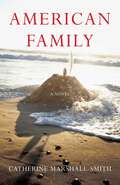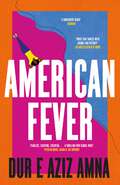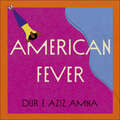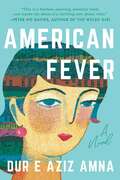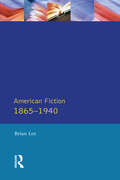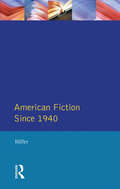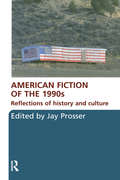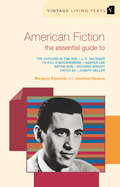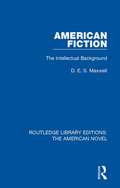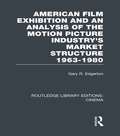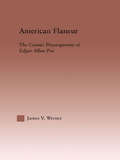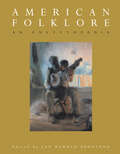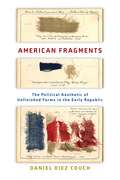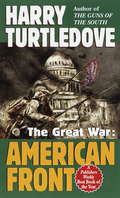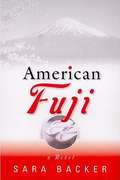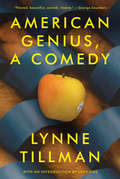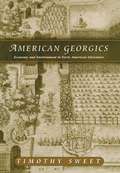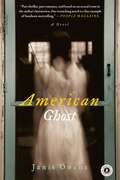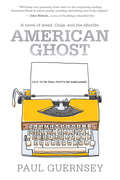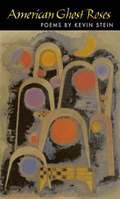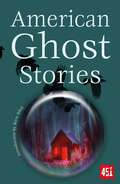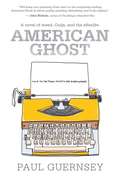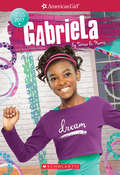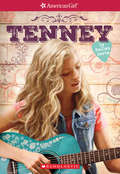- Table View
- List View
American Family: A Novel
by Catherine Marshall-SmithRichard and Michael, both three years sober, have just decided to celebrate their love by moving in together when Richard—driven by the desire to do the right thing for his ten-year-old-daughter, Brady, whom he has never met—impulsively calls his former father-in-law to connect with her. With that phone call, he jeopardizes the one good thing he has—his relationship with Michael—and also threatens the world of the fundamentalist Christian grandparents who love Brady and see her as payback from God for the alcohol-related death of her mother. Unable to reach an agreement, the two parties hire lawyers who have agendas far beyond the interests of the families—and Brady is initially trusted into Richard and Michael&’s care. But when the judge learns that the young girl was present when a questionable act took place while in their custody, she returns Brady to her grandparents. Ultimately, it&’s not until further tragedy strikes that both families are finally motivated to actually act in the &“best interests of the child.&”
American Fever
by Dur e Amna'Unforgettable... Rarely does a book sharpen how you see the world around you, but American Fever does just that. It dazzled me on every page' Julie Buntin, author of MarlenaOn a year-long exchange programme in rural Oregon, sixteen-year-old Hira must swap Kashmiri chai for volleyball practice and understand why everyone around her seems to dislike Obama. An unforgettably witty narrator, Hira finds herself stuck between worlds. The experience is memorable for reasons both good and bad; a first kiss, new friends, racism, Islamophobia, homesickness. Along the way Hira starts to feel increasingly unwell until she begins coughing up blood, and receives a diagnosis of tuberculosis, pushing her into quarantine and turning her newly-established world upside down.'Marks the debut of a thrilling new global voice' Peter Ho Davies'In this sharply observed twist on the classic coming-to-America story, we find an America recognizable in all its generosity, cruelty, and sometimes-well-intentioned bumbling. And we find a brilliant exploration of the sacred, scary moment when a girl comes into the wider world' Benjamin Moser, Pulitzer-Prize-winning author of Sontag: Her Life and Work
American Fever
by Dur e Amna'Unforgettable... Rarely does a book sharpen how you see the world around you, but American Fever does just that. It dazzled me on every page' Julie Buntin, author of MarlenaOn a year-long exchange programme in rural Oregon, sixteen-year-old Hira must swap Kashmiri chai for volleyball practice and understand why everyone around her seems to dislike Obama. An unforgettably witty narrator, Hira finds herself stuck between worlds. The experience is memorable for reasons both good and bad; a first kiss, new friends, racism, Islamophobia, homesickness. Along the way Hira starts to feel increasingly unwell until she begins coughing up blood, and receives a diagnosis of tuberculosis, pushing her into quarantine and turning her newly-established world upside down.'Marks the debut of a thrilling new global voice' Peter Ho Davies'In this sharply observed twist on the classic coming-to-America story, we find an America recognizable in all its generosity, cruelty, and sometimes-well-intentioned bumbling. And we find a brilliant exploration of the sacred, scary moment when a girl comes into the wider world' Benjamin Moser, Pulitzer-Prize-winning author of Sontag: Her Life and Work
American Fever
by Dur e AmnaA deeply compelling and funny coming-of-age novel about a teenaged girl's life-changing journey from Pakistan to America, and the challenges of a debilitating illness.On a year-long exchange programme in rural Oregon, sixteen-year-old Hira must swap Kashmiri chai for volleyball practice and understand why everyone around her seems to dislike Obama. An unforgettably witty narrator, Hira finds herself stuck between worlds. The experience is memorable for reasons both good and bad; a first kiss, new friends, racism, Islamophobia, homesickness. Along the way Hira starts to feel increasingly unwell until she begins coughing up blood, and receives a diagnosis of tuberculosis, pushing her into quarantine and turning her newly-established world upside down.'Unforgettable... Rarely does a book sharpen how you see the world around you, but American Fever does just that.' Julie Buntin, author of Marlena'Marks the debut of a thrilling new global voice' Peter Ho Davies'In this sharply observed twist on the classic coming-to-America story, we find an America recognizable in all its generosity, cruelty, and sometimes-well-intentioned bumbling. And we find a brilliant exploration of the sacred, scary moment when a girl comes into the wider world' Benjamin Moser, Pulitzer-Prize-winning author of Sontag: Her Life and Work (P) 2022 Hodder & Stoughton Limited
American Fever: A Novel
by Dur e Aziz AmnaUSA Today Best books of August Christian Science Monitor Ten Best Books of August The Millions Most Anticipated Books of 2022 Harper's Bazaar Must-Read Books of August 2022 Debuts of the Season by Vogue India Bustle Most Anticipated Books of August 2022 "A funny and affecting novel...a wonderful new spin on the coming-of-age story. A smart, charming debut." (Kirkus, starred review) "A fascinating mix of immigrant tale, coming-of-age narrative, and cultural exposition...tackling some of the big migration questions of home and identity." (Booklist)&“This is a fearless, exacting, essential work, and marks the debut of a thrilling new global voice.&”—Peter Ho Davies, author of The Welsh Girl On a year-long exchange program in rural Oregon, a Pakistani student, sixteen-year-old Hira, must swap Kashmiri chai for volleyball practice and try to understand why everyone around her seems to dislike Obama. A skeptically witty narrator, Hira finds herself stuck between worlds. The experience is memorable for reasons both good and bad; a first kiss, new friends, racism, Islamophobia, homesickness. Along the way Hira starts to feel increasingly unwell until she begins coughing up blood, and receives a diagnosis of tuberculosis, pushing her into quarantine and turning her newly established home away from home upside down. American Fever is a compelling and laugh-out-loud funny novel about adolescence, family, otherness, religion, the push-and-pull of home. It marks the entrance on the international literary scene of the brilliant fresh voice of Dur e Aziz Amna.
American Fiction 1865 - 1940 (Longman Literature In English Series)
by Brian LeeBrian Lee's study of American fiction from 1865 to 1940 draws on a wealth of material by, amongst others, Twain, James, Dreiser, Hemingway, Fitzgerald and Faulkner. Though the works of these writers have been closely scrutinised by postwar critics in Europe and America, few attempts have yet been made to utilise the new critical approaches and theories in the service of literary history. Brian Lee does so in this book, relating the writers of the period - both major and minor - to its patterns of immense economic, social and intellectual change.
American Fiction Since 1940 (Longman Literature In English Series)
by Tony HilferIn this remarkable book, Tony Hilfer provides a major survey of the wealth of post-war American fiction. He analyses the major modes and genres of writing, from realist to postmodernist metafiction and black humour, the fiction of social protest, women's writing, and the traditions of African-American, Southern and Jewish-American fiction. Key writers discussed include William Faulkner, Norman Mailer, Ralph Ellison, Saul Bellow, Joseph Heller, Vladimir Nabokov and Joyce Carol Oates. The book concludes by exploring contemporary trends through detailed case-studies of Donald Barthelme and Toni Morrison.
American Fiction of the 1990s: Reflections of history and culture
by Jay ProsserAmerican Fiction of the 1990s: Reflections of History and Culture brings together essays from international experts to examine one of the most vital and energized decades in American literature. This volume reads the rich body of 1990s American fiction in the context of key cultural concerns of the period. The issues that the contributors identify as especially productive include: Immigration and America’s geographical borders, particularly those with Latin America Racial tensions, race relations and racial exchanges Historical memory and the recording of history Sex, scandal and the politicization of sexuality Postmodern technologies, terrorism and paranoia American Fiction of the 1990s examines texts by established authors such as Don DeLillo, Toni Morrison, Philip Roth and Thomas Pynchon, who write some of their most ambitious work in the period, but also by emergent writers, such as Sherman Alexie, Chang-Rae Lee, E. Annie Proulx, David Foster Wallace, and Jonathan Franzen. Offering new insight into both the literature and the culture of the period, as well as the interaction between the two in a way that furthers the New American Studies, this volume will be essential reading for students and lecturers of American literature and culture and late twentieth-century fiction. Contributors include: Timothy Aubry, Alex Blazer, Kasia Boddy, Stephen J. Burn, Andrew Dix, Brian Jarvis, Suzanne W. Jones, Peter Knight, A. Robert Lee, Stacey Olster, Derek Parker Royal, Krishna Sen, Zoe Trodd, Andrew Warnes and Nahem Yousaf.
American Fiction: The Essential Guide To (Vintage Living Texts #15)
by Margaret Reynolds Jonathan NoakesCatch 22, Cather in the Rye, To Kill a Mocking Bird and Native Son- this guide deals with the themes, genre and narrative techniques of these four classic American novels, with an emphasis on providing a rich source of ideas for intelligent and inventive ways of approaching the novels. Amongst many other features you'll find inpsirational reading plans and contextual material, suggested complementary and comparative reading and an indispensable glossary.
American Fiction: The Intellectual Background (Routledge Library Editions: The American Novel #11)
by D. E. MaxwellOriginally published in 1963. The ‘Americanness’ of the American novel is as readily apparent as it is elusive of definition. It is the purpose of this study not to discover the reluctant formula, the comprehensive statement of national identity, but to examine the evidences of this identity in the work of some individual American writers. This study explores the works of many prominent American authors including Edgar Allan Poe, Nathanial Hawthorne, and Mark Twain.
American Film Exhibition and an Analysis of the Motion Picture Industry's Market Structure 1963-1980 (Routledge Library Editions: Cinema)
by Gary EdgertonThis study looks at how the movie industry organisation functioned between the late ‘40s and 1983 when it was originally published. It describes the changing role of domestic exhibition through this time and analyses the wider film industry to provide a model of the exhibition structure in relation to production, distribution and outside factors. It addresses the growing issues of the cable and video markets as competition to the film exhibition business at that time and looks forward into a highly turbulent environment. With particular interest now as the film industry address a new range of threats and adaptations of its working structure, this book offers and integral understanding of a key stage in cinema history.
American Flaneur: The Cosmic Physiognomy of Edgar Allan Poe (Studies in Major Literary Authors)
by James WernerAmerican Flaneur investigates the connections between Edgar A. Poe and the nineteenth-century flaneur - or strolling urban observer - suggested in Walter Benjamin's discussion of Baudelaire. This study illustrates the centrality of the flaneur to Poe's literary aims, and uses the flaneur to illuminate Poe's intimate yet ambivalent relationship to his surrounding culture. While James V. Werner concentrates on Poe's fiction, this book treats many areas of nineteenth-century intellectual and popular culture, including science and pseudo-science, the American magazine marketplace, urban topology, the grotesque, labyrinths, narratives of exploration and discovery, and cosmological treatises. Werner draws on Marxist, reader response and periodical theories while reconstructing Poe through examinations of ephemeral texts of the time.
American Folklore: An Encyclopedia
by Jan Harold BrunvandContains over 500 articles Ranging over foodways and folksongs, quiltmaking and computer lore, Pecos Bill, Butch Cassidy, and Elvis sightings, more than 500 articles spotlight folk literature, music, and crafts; sports and holidays; tall tales and legendary figures; genres and forms; scholarly approaches and theories; regions and ethnic groups; performers and collectors; writers and scholars; religious beliefs and practices. The alphabetically arranged entries vary from concise definitions to detailed surveys, each accompanied by a brief, up-to-date bibliography.Special features *More than 2000 contributors *Over 500 articles spotlight folk literature, music, crafts, and more *Alphabetically arranged *Entries accompanied by up-to-date bibliographies *Edited by America's best-known folklore authority
American Fragments: The Political Aesthetic of Unfinished Forms in the Early Republic
by Daniel Diez CouchIn the years between the independence of the colonies from Britain and the start of the Jacksonian age, American readers consumed an enormous number of literary texts called "fragments." American Fragments recovers this archive of the romantic period to raise a set of pressing questions about the relationship between aesthetic and national realities: What kind of artistic creation was a fragment?, And how and why did deliberately unfinished writing emerge alongside a country that was itself still unfinished?Through discussions of eighteenth-century transatlantic aesthetics, the Revolutionary War, seduction novels, religious culture, and the construction of authorship, Daniel Diez Couch argues that the literary fragment was used as a means of representing individuals who did not fit neatly into the social fabric of the nation: beggars, prostitutes, veterans, and other ostracized figures. These individuals did not have a secure place in designs for the country's future, yet writers wielded the artistic form of the fragment as an apparatus for surveying their disputed positionality. Time and again, fragments asked what kind of identity marginalized individuals had, and how fictionalized versions of their life stories influenced the sociopolitical circumstances of the emergent nation. In their most progressive moments, the writers of fragments depicted their subjects as being "in process," opting for a fluid version of the self instead of the bounded and coherent one typically hailed as the liberal individual.Traversing aesthetics, political philosophy, material culture, and history, American Fragments gives new life to a literary form that at once played a significant role in the print ecology of the early republic, and that endures in the works of modernist and postmodernist writers and artists.
American Front: American Front (Southern Victory: The Great War #1)
by Harry TurtledoveWhen the Great War engulfed Europe in 1914, the United States and the Confederate States of America, bitter enemies for five decades, entered the fray on opposite sides: the United States aligned with the newly strong Germany, while the Confederacy joined forces with their longtime allies, Britain and France. But it soon became clear to both sides that this fight would be different--that war itself would never be the same again. For this was to be a protracted, global conflict waged with new and chillingly efficient innovations--the machine gun, the airplane, poison gas, and trench warfare.Across the Americas, the fighting raged like wildfire on multiple and far-flung fronts. As President Theodore Roosevelt rallied the diverse ethnic groups of the northern states--Irish and Italians, Mormons and Jews--Confederate President Woodrow Wilson struggled to hold together a Confederacy still beset by ignorance, prejudice, and class divisions. And as the war thundered on, southern blacks, oppressed for generations, found themselves fatefully drawn into a climactic confrontation . . .From the Paperback edition.
American Fuji
by Sara Backer?Japan itself is the comic hero of American Fuji?sweet and funny, sad and inspiring.? Gaby Stanton, an American professor living in Japan, has lost her job teaching English at Shizuyama University. (No one will tell her exactly why.) Alex Thorn, an American psychologist, is mourning his son, a Shizuyama exchange student who was killed in an accident. (No one will tell him exactly how.) Alex has come to this utterly foreign place to find the truth, and now Gaby is serving as his translator and guide. The key to mastering Japanese, she keeps telling him, is understanding what's not being said. And in this "deft and delightful" (Karen Joy Fowler) novel, the unsaid truths about everything from work and love to illness and death cast a deafening silence-and tower in the background like Mount Fuji itself.
American Genius: A Comedy
by Lynne TillmanGrand and minute, elegiac and hilarious, Lynne Tillman expands the possibilities of the American novel in this dazzling read about a former historian ruminating on her own life and the lives of others--named a best book of the century by Vulture.In the hypnotic, masterful American Genius, A Comedy, a former historian spending time in a residential home, mental institute, artist’s colony, or sanitarium, is spinning tales of her life and ruminating on her many and varied preoccupations: chair design, textiles, pet deaths, family trauma, a lost brother, the Manson family, the Zulu alphabet, loneliness, memory, and sensitive skin--and what “sensitivity” means in our culture and society.Showing what might happen if Jane Austen were writing in 21st-century America, Tillman fashions a microcosm of American democracy: a scholarly colony functioning like Melville's Pequod. All this is folded into the narrator's memories and emotional life, culminating in a seance that may offer escape and transcendence--or perhaps nothing at all. This new edition of a contemporary classic features an introduction by novelist Lucy Ives.
American Georgics
by Timothy SweetIn classical terms the georgic celebrates the working landscape, cultivated to become fruitful and prosperous, in contrast to the idealized or fanciful landscapes of the pastoral. Arguing that economic considerations must become central to any understanding of the human community's engagement with the natural environment, Timothy Sweet identifies a distinct literary mode he calls the American georgic.Offering a fresh approach to ecocritical and environmentally-oriented literary studies, Sweet traces the history of the American georgic from its origins in late sixteenth-century English literature promoting the colonization of the Americas through the mid-nineteenth century, ending with George Perkins Marsh's Man and Nature (1864), the foundational text in the conservationist movement.
American Ghost
by Janis OwensJOLIE HOYT IS A GOOD SOUTHERN GIRL living in Hendrix, a small Florida Panhandle town. The daughter of a Pentecostal preacher who sells insurance on the side, and the best friend of a lively beauty who moves to the big city to pursue a career in interior design, Jolie is all too aware of her family's closet full of secrets and long-held distrust of outsiders. Nevertheless, she throws caution to the wind when she meets Sam Lense, a Jewish anthropology student from Miami, who is in town to study the ethnic makeup of the region. Jolie and Sam fall recklessly in love and dream of beginning a life together, far away from Jolie's buried past. But their affair ends abruptly when Sam is discovered to have pried too deeply into Hendrix's dark racial history and he becomes the latest victim in a long tradition of small-town violence. Twelve years later, when a black businessman from Memphis returns to Hendrix to do right by his father's memory, Jolie and Sam are brought together again. They are forced to revisit the unresolved issues of their young love and finally shed light on the ugly history of Jolie's hometown. A complex and compulsively readable Southern saga, continuing in the tradition established by Marjorie Kinnan Rawlings and brought into the new millennium by writers like Karen Russell and Kathryn Stockett, American Ghost was inspired by Janis Owens's extensive research on a real lynching that occurred in 1934 in Marianna, Florida. American Ghost is a richly woven exploration of how the events of our past haunt our present.
American Ghost
by Paul GuernseyThumb Rivera is in a bind. A college dropout, aspiring writer, smalltime marijuana grower, and biker club hang-around, Thumb finds himself confined to his rural ranch house in the desolate Maine countryside, helpless to do anything but watch as his former friends and housemates scheme behind his back, conspire to steal his girlfriend, and make inroads with the Blood Eagles, a dangerous biker gang.Thumb is also dead.A ghost forced to haunt his survivors and reflect back on the circumstances that led to his unsolved murder, Thumb discovers he has one channel through which he can communicate with the living world: Ben, an unemployed ghost hunter. Ben soon convinces local curmudgeon Fred Muttkowski, failed novelist turned pig farmer, to turn Ben's Ouija-board conversations with Thumb into an actual book.Thumb has two things on his mind: To solve, and then avenge, the mystery of his own violent death, and also to tell his story. That story is American Ghost-as told to Ben, then fictionalized by Fred. It's at once a clever tale of the afterlife, a poignant examination of the ephemeral nature of life, and a celebration of writing and the written word.
American Ghost Roses
by Kevin SteinIn his first book as the poet laureate of Illinois, Kevin Stein shoulders an array of poetic forms, blending pathos, humor, and social commentary. These poems--ranging from meditative narratives to improvisational lyrics--explore art's capacity to embody as well as express contemporary culture. Stein embraces subjects as various as his father's death, magazine sex surveys, Kandinsky's theory of art, the dangling modifier, Jimi Hendrix's flaming guitar, racial bigotry, and a teacher's comments on a botched poem. Presiding over this miscellany are ghosts of a peculiarly American garden of dreamers and beloved misfits, those redeemed and those left fingering the locked gate
American Ghost Stories (Ghost Stories)
by Flame TreeAmerican ghosts stories have their origins in the gothic, mixed with the fears of the pioneer landscapes. A terrific new collection of classic talesSettling in for a night of spine-chilling entertainment? Here's a gripping collection of classic American ghost tales by authors such as Edgar Allan Poe ('The Masque of the Red Death'), Francis Bret Harte ('The Ghosts of Stukeley Castle'), Edith Wharton ('Afterward'), Mark Twain ('A Ghost Story'), Harriet Beecher Stowe ('The Ghost in the Mill'), O. Henry ('A Ghost of a Chance'), H.P. Lovecraft ('The Outsider') and many more.FLAME TREE 451: From myth to mystery, the supernatural to horror, fantasy and science fiction, Flame Tree 451 offers a healthy diet of werewolves and mechanical men, blood-lusty vampires, dastardly villains, mad scientists, secret worlds, lost civilizations and escapist fantasies. Discover a storehouse of tales gathered specifically for the reader of the fantastic.
American Ghost: A Novel of Weed, Ouija, and the Afterlife
by Paul Guernsey***WINNER OF THE 2018 MAINE LITERARY AWARD FOR SPECULATIVE FICTION***An inventive metafictional novel, in which a drug-dealing biker must solve his own murder from beyond the grave.Thumb Rivera is in a bind. A college dropout, aspiring writer, smalltime marijuana grower, and biker club hang-around, Thumb finds himself confined to his rural ranch house in the desolate Maine countryside, helpless to do anything but watch as his former friends and housemates scheme behind his back, conspire to steal his girlfriend, and make inroads with the Blood Eagles, a dangerous biker gang.Thumb is also dead.A ghost forced to haunt his survivors and reflect back on the circumstances that led to his unsolved murder, Thumb discovers he has one channel through which he can communicate with the living world: Ben, an unemployed ghost hunter. Ben soon convinces local curmudgeon Fred Muttkowski, failed novelist turned pig farmer, to turn Ben’s Ouija-board conversations with Thumb into an actual book.Thumb has two things on his mind: To solve, and then avenge, the mystery of his own violent death, and also to tell his story. That story is American Ghost?as told to Ben, then fictionalized by Fred. It's at once a clever tale of the afterlife, a poignant examination of the ephemeral nature of life, and a celebration of writing and the written word.
American Girl: 2017, Novel 1 (American Girl: Girl of the Year 2017 #1)
by Teresa E. HarrisIntroducing American Girl's 2017 Girl of the Year! Find out how the girl's story began in this first of four novels.
American Girl: Contemporary MG Series 1, Novel 1 (Tenney Grant #1)
by Kellen HertzA new middle grade series featuring contemporary characters!
